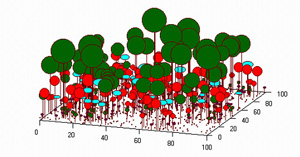Individual and Agent based Modelling

Individual based/agent based models (ABMs) explicitly represent organisms as discrete and unique entities, such as individual trees or birds, but also humans. ABMs are used when one or more of the following aspects, which are difficult to deal with in analytical models, are considered important: trait variability among individuals, local interactions, adaptive behaviour based on decision making, and heterogeneous and dynamic environments. Most of the simulation models developed in the Department of Ecological Modelling (OESA) include at least one individual or agent based aspect. The forest model FORMIND, and the grassland model GRASSLAND, are based on photosynthesis and competition for light. ABMs play a key role in our models of social-ecological systems, which mostly are addressing questions about land use, sustainability, and biodiversity, e.g. InsuranceGrass. Both GRASSMIND and the BEEHAVE honeybee model are currently being transformed into digital twins, i.e. embedded in a workflow to regularly update and improve the models with new data. As the response of ecosystems to changes in climate and land use emerges from the responses of organisms, people and institutions, mechanistic Digital Twins are ideally based on ABMs. Because of the increasingly recognised importance of including the behaviour and response of individuals. OESA was involved in the start of the new journal Individual-based Ecology and in the production of the first textbook in agent-based modelling. Both, the ODD protocol for communicating IBMs, for communicating IBMs, and „pattern-oriented modelling“, a strategy to make models structurally realistic, were launched by OESA.
Selected Publications
Selected Publications
- Groeneveld, J., Martinovic, T., Rossi, T., Salamon, O., Sara-aho, K., Grimm, V. (2024):
Prototype Biodiversity Digital Twin: honey bees in agricultural landscapes
Res. Ideas Outcomes 10 , e125167 10.3897/rio.10.e125167 - Grimm, V., Railsback, S.F., Vincenot, C.E., Berger, U., Gallagher, C., DeAngelis, D.L., Edmonds, B., Ge, J., Giske, J., Groeneveld, J., Johnston, A.S.A., Milles, A., Nabe-Nielsen, J., Polhill, J.G., Radchuk, V., Rohwäder, M.-S., Stillman, R.A., Thiele, J.C., Ayllón, D. (2020):
The ODD protocol for describing agent-based and other simulation models: A second update to improve clarity, replication, and structural realism
JASSS 23 (2), art. 7 10.18564/jasss.4259 - Grimm, V., Ayllón, D., Railsback, S.F. (2017):
Next-generation individual-based models integrate biodiversity and ecosystems: yes we can, and yes we must
Ecosystems 20 (2), 229 - 236 10.1007/s10021-016-0071-2 - Stillman, R.A., Railsback, S.F., Giske, J., Berger, U., Grimm, V. (2015):
Making predictions in a changing world: the benefits of individual-based ecology
Bioscience 65 (2), 140 - 150 10.1093/biosci/biu192
